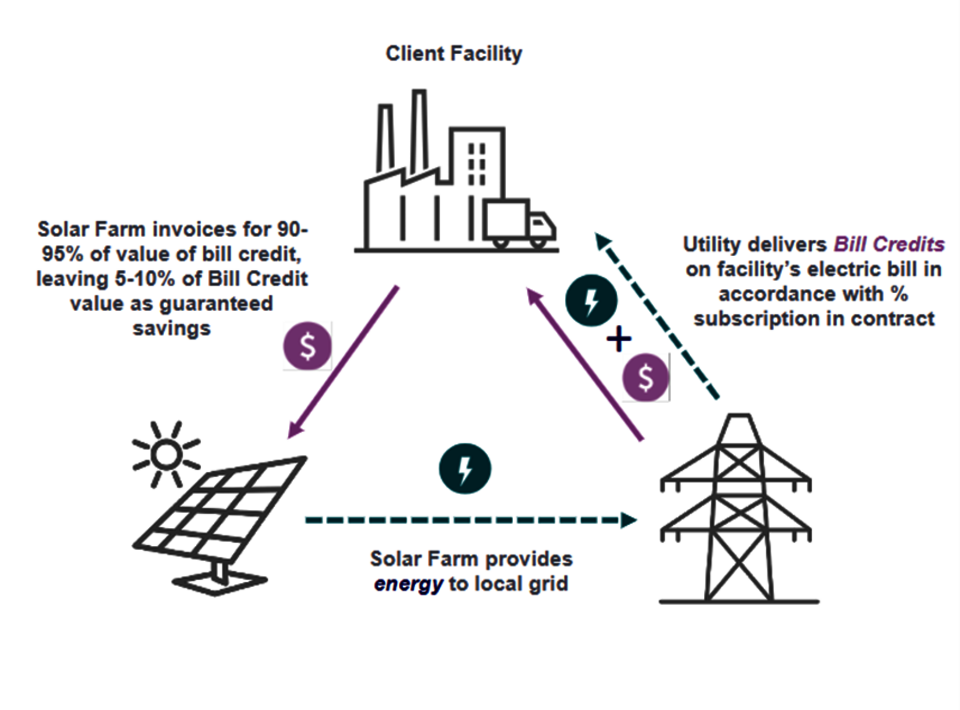Community Solar 101: What does it mean for your business?

By Chris Hillebrand, Manager, DER Advisory
With increasing interest in the concept of corporate sustainability from both customers and business partners alike, it has never been more important for businesses to evaluate the options they may have at their disposal to reduce their environmental impact.
For many, the act of “going green” and pursuing benefits from technologies like solar systems immediately leads to expectations of solar panels at every location, but this isn’t always practical. While onsite solar should certainly be a consideration that Trio can evaluate and support it is just one option in an arsenal of opportunities that a facility or business can look to as a way to meet their sustainability goals.
For sites where onsite solar may prove to be too challenging to install or too costly to meet your organization’s economic hurdles, another alternative to make meaningful and tangible impact would be to explore the potential benefits of community solar.
What is community solar?
Community solar is an opportunity for both businesses and homeowners to subscribe to solar farms located within their local electric utility and receive between 5-20% guaranteed electric bill savings and potential environmental benefits, such as Renewable Energy Credits (RECs) from the solar asset. An important distinction from standard onsite solar systems is that community solar projects do not need to be located on your property, but instead can be sited several counties over. It is this flexibility that opens the opportunity to solar benefits to not only those with large rooftops or parking lots, but to everyone in the area that has an electric meter.
How does community solar work?
How community solar delivers guaranteed savings on your electric bills varies from state to state, but in general, the process a subscriber can expect would be:
- Subscribe to a community solar system located somewhere in their electric utility for a certain percentage of the overall system size.
- The community solar system will begin generating energy, which will then be injected directly into the local electric utility’s distribution grid for the utility to use.
- In recognition of the community solar system providing energy to the electric utility, it will look to deliver compensation correlated to the value of the energy delivered.
- Instead of providing the value of energy delivered directly to the community solar farm, however, the electric utility will include compensation for the energy delivered to the grid on the electric bills of subscribers to the projects in the form of a credit. This will be calculated based on the percentage of the system that has been subscribed to. The subscriber can then use this credit to reduce their electric bill spend.
- To bring some compensation back to the community solar system itself, the project owner will then invoice the subscriber for a fixed percentage of the value placed on the subscriber’s bill - typically between 80-95% of the total value - leaving between 5-20% of the value remaining as guaranteed savings.
- Optional: In some instances, the community solar system will also deliver associated project RECs to the subscriber, or RECs from an alternative source that can be claimed towards their sustainability goals.
Example:
Client X subscribes to 40% of a local community solar farm and receives a 10% guaranteed discount. In June, the community solar farm generates $25,000 worth of energy and provides that to the utility.
Considering Client X is subscribed to 40% of the project, they then receive 40% of the compensation for the energy (40% of $25,000), which is an $8,000 credit on their bill.
The following month, the community solar farm will then invoice Client X for 90% of the $8,000, leaving them 10%, or $800, to claim as savings.

What are the benefits and limitations when considering subscribing to a community solar system?
There are many reasons to consider pursuing community solar, including:
- Guaranteed savings – Due to the contract being a fixed percentage of the value delivered, there will always be some value provided to the facility, with no risk of negative cashflow to a subscriber.
- Simplicity with near-term benefits - Project contracts are generally simpler than other types of energy procurements, needing fewer internal resources to mobilize. Projects identified as potential partners are significantly less risky due to their typically guaranteed benefits and nearer-term timelines when compared to other types of transactions that may require longer timelines.
- A true “community” endeavor- While businesses typically subscribe to up to 40-50% of a given project, the remaining subscribers are often local homeowners, where additional benefits can sometimes be provided to those community solar projects working with Low-to-Moderate Income households as subscribers. By participating in a community solar project, a business can feel confident that they are playing a critical role in enabling those in their community to not only support the environment, but also facilitating energy savings to those who may benefit the most.
For all of its benefits, challenges do exist when looking to sign onto a community solar program:
- Geography limitations- Despite community solar becoming increasingly topical at the national level, the structure has only been adopted in a handful of states. When looking to participate, it is critical to see what options may be available based on the location of your load.
- Picking the right partner/project- When pursuing community solar in each market, it is prudent to try to get multiple bids, when possible, as projects may sometimes be too early-stage to be worth signing up for or may have terms that are generally out of market.
Where can I participate?
With a high dependence on geographic footprint for community solar availability, a business may ask themselves: Where do I need to have a site to consider community solar? Currently, the most mature markets in the U.S. where community solar is either available or has previously been available but may have limited opportunities for subscribers are:
Colorado, Illinois, Maine, Maryland, Massachusetts, Minnesota, New Jersey, New Mexico, New York
While this list covers most of the optimal opportunities, programs continue to be created in other states or revised in existing states to create opportunities for businesses and homeowners to tap into the benefits of distributed-generation solar. If your business would like to explore the opportunities that may exist for you, please reach out to the Trio team for an initial review.
How can Trio help?
While community solar can be a streamlined process, having the right partner in your corner can be key to setting you and your business up for long-term success as a subscriber. Some of the key services that our Distributed Energy Advisory team can offer to ensure you are getting the best deal possible include:
- Opportunity assessment - the Trio team will review all of your electric bills in key markets to help identify specific opportunities that may exist for you to receive energy bill savings or environmental benefits through this type of transaction structure.
- Competitive solicitation - the Trio team will leverage our existing developer network to find projects in the right markets for you. Should there be multiple opportunities for a single facility, our team will assess each project based on development maturity, economic benefit, and any other criteria which may be important for your organization when picking a long-term partner.
- Contract negotiation - community solar offtake agreements can be relatively simple when compared with other energy transaction contracts, but they do have their challenges. Our team is experienced in community solar contract negotiation and can ensure that your organization’s best interests are represented and fulfilled.
- Ongoing support- Once contracts are executed and projects get built, the Trio team can provide ongoing support to ensure that the financial bills savings are flowing in accordance with the structure outlined in your contract.
Community solar is becoming an increasingly popular and impactful way of supporting businesses who are looking to achieve their sustainability goals. If your organization is looking to better understand what opportunities may exist for you, please reach out to Trio’s Distributed Energy Advisory team for support.
